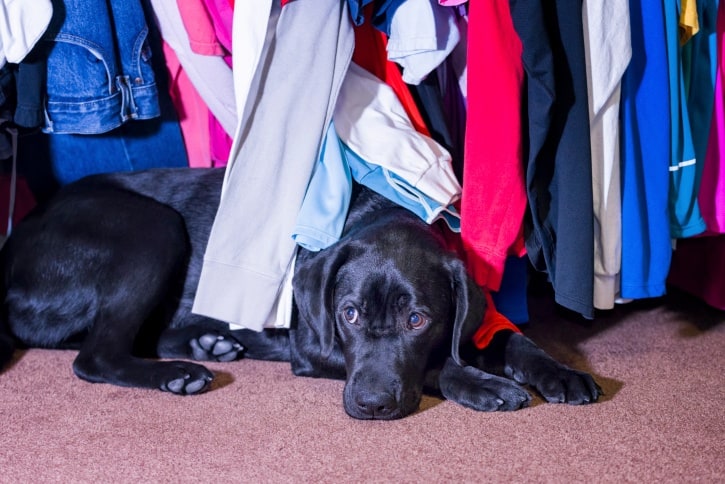
For many, New Years and Independence Day are some of the best days of the year: backyard barbecues, parades, and amazing fireworks displays to ring in the start of a fabulous new year or celebrate our nation’s independence.
But for many pet parents, these are the most dreaded days of the year.

For those of us with fearful dogs, the evening is often spent comforting a panicked pooch from the first crackle to the grand finale. We use Thundershirts, essential oils, soothing music, and more to calm our stressed-out dogs, often only finding relief when the explosions finally die down.
Instead of just dreading the big day, why not start to prepare now?
A fear of loud noises and novelty sounds, particularly fireworks and thunderstorms are common for many dogs. This can be extremely problematic and stressful for both dog and owner. As a result, I created a playlist of various sound effects to help solve this issue. You can use it to positively condition a not yet fearful dog or desensitize and counter-condition an already fearful dog.
When it comes to training a dog to sounds, we cannot use a real storm or fireworks display, as these events happen too quickly and are often unexpected. That is why prerecorded sounds are so important, we are in direct control of the timing, volume, and duration. It is essential that the training protocol be implemented gradually and over prolonged periods of time.
Step 1: Start the sound track a low level that your dog does not even hear it. It must not invoke a fearful response. Dogs have much better hearing than us, so error on the side of caution and start lower in volume.
Step 2: This is a slow and strategic process, only increase the volume one “notch” each training session. The biggest mistake one can make, is increasing the stimuli too quickly, resulting in a fear response.
Step 3: While the sound track is playing, create a positive and happy association for your dog. You can: periodically treat your dog with a high value snack (hot dog, cheese, turkey, etc.), play your dog’s favorite game (tug, fetch, etc.) or practice various obedience commands. This will keep your dog’s mind focused on productive and happy activities.
Step 4: Once your dog has progressed to being non-reactive toward the sounds at an appreciable level, restart this scenario in different rooms of the house. Varying the context will help the dog to generalize the fact that these sounds are not “bad”.
There are other variables that can trigger a fear response, such as atmospheric changes during thunder storms, startling flashes from lightening, and vibration from fireworks. Those are hard to artificially create, so we are focusing on what we can control (i.e. the sounds).
If (when) your dog does respond fearfully to one of the sounds at a specific volume, take a step back by lowering the volume to a previous level and resume the process at that level. Then gradually increase again when the dog is ready.
This protocol can help rehabilitate fearful dogs and prevent issues in puppies and non-reactive dogs. Make sure to start the process of positively conditioning, desensitizing, and counter conditioning now. Don’t try to train your dog 2 days before hurricane season or on July 3rd. Conduct short and frequent training sessions each day, over several weeks.
*Note: Subscribe to my YouTube channel, as I will be frequently updating this playlist with a variety of sounds that dogs commonly react negatively to, including motorcycles, baby crying, doors slamming, hair dryers, sirens and more. If you have a recommendation for a specific sound to be added, please leave it in the comments section below.
Steve Reid is a professional dog trainer and owner of S.R. Dog Training in Westchester NY. For more info about dog training and puppy training. Please also become a fan of Steve on Facebook at www.Facebook.com/SRDogTraining.



